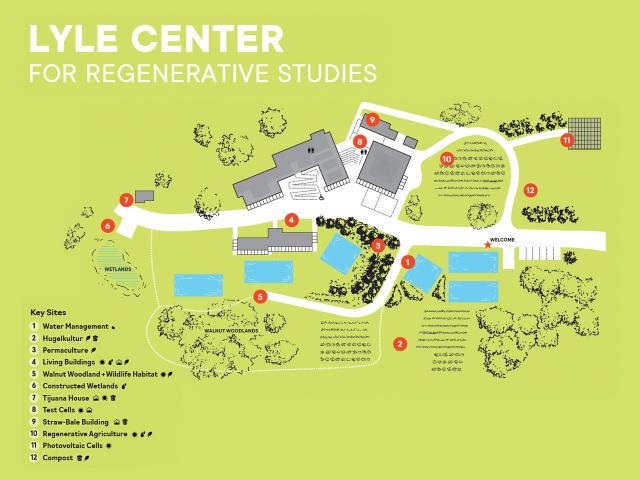Visitor Guide

The mission of the Lyle Center is to advance the principles of environmentally sustainable living. Our students, faculty and community work to design and implement interdisciplinary solutions that regenerate natural systems while integrating the needs and capacity of the community. We believe the Lyle Center is a useful model for understanding how to design and live within systems that can regenerate our world.
The land upon which the Center now stands was used as cattle-grazing land for many years, but just two decades ago this site was also the location of the Spadra Landfill. The has since been restored into a living ecosystem supporting many plant and animal communities across our 16-acre site.
There are 12 key sites that demonstrate the system of regenerative strategies developed by founding director John T. Lyle. Below is a brief primer explaining the details and rationale behind each strategy. The full details, along with the Center's walking tour map, are in the official Visitor Guide.
-
Water Management. The hillsides have been carefully shaped using landform techniques to capture and direct rainwater and minimize erosion. The vast majority of our landscape is irrigated with reclaimed water via drip irrigation, which maximizes efficiency and drastically reduces losses to runoff and evaporation.
-
Hugelkultur. Hugelkultur is a soil-building technique that uses decaying wood as a revitalizing resource. Fallen tree branches, logs, and other waste wood are collected, stacked into mounds, and covered with soil. As the wood slowly decomposes, it becomes a spongy, dark, and crumbly planting medium which absorbs water, promotes plant growth, and encourages a thriving soil ecosystem.
-
Permaculture. Permaculture is a land management philosophy focused on working with, rather than against, nature, in order to produce landscapes that provide for people’s needs while maintaining the health and resiliency of natural ecosystems. Our permaculture garden features a “Food Forest”— a diverse interplanting of edible crops designed to mimic a forest ecosystem.
-
Living Buildings. The Lyle Center is an active academic facility with classrooms, laboratories, and offices. Using passive design strategies, the buildings here are designed to minimize the amount of energy required for heating and cooling of the interior spaces, reducing building carbon emissions.
-
Walnut Woodland + Wildlife Habitat. The Lyle Center and adjacent areas were once part of what was likely one of the largest walnut woodlands in North America. Sadly, much of this habitat has been degraded over the years by grazing and construction. Our restoration efforts over the years have allowed these walnut trees to survive and flourish on our site. Today, this is one of the largest walnut woodlands in the area and is home to a diverse array of wildlife including long-tailed weasels, California quail, and Cooper’s hawks.
-
Constructed Wetlands. Wetlands are an important but vanishing ecosystem in California and are vital to many species of migratory water bird. Our human-made wetland consists of a large depression situated at the lowest point of our site, where water naturally collects.
-
Tijuana House. The Tijuana House was developed by Cal Poly students and faculty, in partnership with the nonprofit organization Corazon, as a potential solution to the low-cost housing needs in Mexico. This housing prototype uses affordable and sustainable low-carbon design strategies which can be replicated in impoverished areas.
-
Test Cells. The Test Cells are used by Cal Poly faculty and students to experiment with passive heating and cooling systems in the particular climate of Southern California. These test cells provide an opportunity to do advanced applied research, which can eventually be implemented in real buildings.
-
Straw-Bale Building. The Straw Bale Building uses agricultural waste products as a resource to create an all-natural building material that is affordable, fire-resistant, and well-insulated. Straw bales can be made from by-products of wheat, oats, rye, barley, and rice.
-
Regenerative Agriculture. Food production is a core feature of the Lyle Center, and takes place both in dedicated garden areas and as an integrated part of the general landscape. Our regenerative agriculture strategies focus on producing edible crops while simultaneously improving (rather than degrading) the health of the whole system including soil, water, and biodiversity.
-
Photovoltaic Cells. The two arrays of PV cells here are designed to generate 210,000 kWh of renewable energy a year — displacing 85 metric tons of greenhouse gases. The solar systems here would meet the Center’s energy demands without generating greenhouse gas emissions. The Center is designed to be a net zero or “carbon neutral” facility.
-
Compost. At the Center, we collect and compost virtually all of the green waste produced on site, keeping carbon on the ground. This saves the waste from the landfill, where it would become a source of methane emissions. The finished compost from our large-scale piles and small-scale worm bin are returned to our landscapes as a soil amendment, eliminating the need for synthetic fertilizers and keeping the carbon embodied in the plant material and out of the atmosphere.